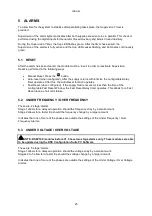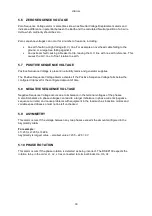
Alarms
31
5.5.8 VECTOR SHIFT
Indicates that a Vector Shift in one or more of the monitored phases of the waveform has been
measured greater than the configured settings of the Vector Shift alarm.
Vector Shift detection of ‘mains failure when in parallel’ relies upon the relative steady state of the
utility power grid.
Should the utility supply fail, the resulting change in load of the local supply (example local site
generator) leads to a jump in the phase of the local supply.
If this jump is greater than the setting of the Vector Shift Alarm, the trip is generated.
5.5.9 EXAMPLE OF A VECTOR SHIFT (INCREASE IN LOAD UPON MAINS FAILURE)
Waveform of Supply in normal operation
Waveform upon mains failure caused by
sudden jump in load on the local supply
(generator)
Waveform of connected supply overlaid with Waveform after mains failure
The period of the supply waveform is continuously measured. For example for a 50Hz supply, the
period is 1/50
th
of a second (20ms).
Should a mains failure occur, the supply ‘jumps’ causing a change in the position of the waveform.
This is measured as a difference in period of the supply waveform for a single cycle.
For our example we will imagine that we have measured 20ms for the previous cycle, and 22ms for
the current cycle. From this we can calculate the difference in degrees.
As one complete cycle is 360º we can calculate the angle of the time difference (2mS).
(2 / 20) x 360 = 36º
If this angle is greater than the setting of the Vector Shift Alarm, a trip is generated.
Mains Failure
event
Period of waveform
before mains failure
Period of waveform after
mains failure (longer)
Period of waveform had the
mains failure not occurred
Содержание DSEP100
Страница 14: ...Installation 14 3 2 2 MAINS BREAKER AND GENERATOR COMMON BUS BREAKER...
Страница 15: ...Installation 15 3 2 3 ALTERNATE TOPOLOGY WIRING DIAGRAMS...
Страница 41: ...This Page is Intentionally Blank...
Страница 42: ...This Page is Intentionally Blank...












































